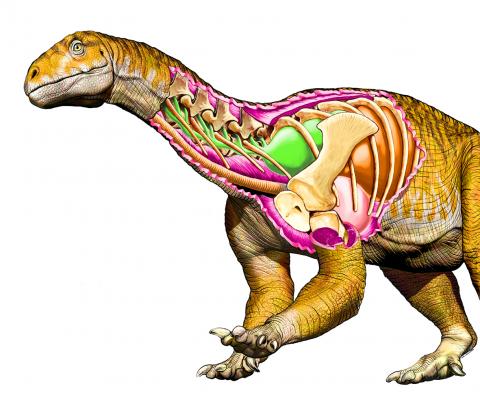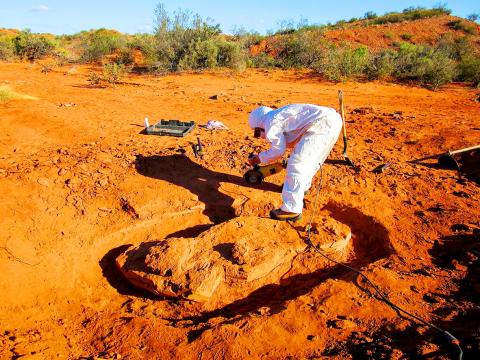Giant dinosaurs lived on Earth much earlier than previously thought, according to a team of excavators in Argentina who discovered the remains of a 200 million-year-old species.
The species, baptized Ingentia prima, was about three times the size of the largest Triassic dinosaurs from its era.
It was discovered in the Balde de Leyes dig site in San Juan Province, 1,100km west of the capital, Buenos Aires.

Photo: Reuters
The find was published on Monday in the specialist journal Nature Ecology and Evolution and revealed in Argentina by the National University of La Matanza’s Scientific Dissemination Agency.
“As soon as we found it, we realized it was something different. We found a shape, the first giant one among all the dinosaurs. That’s the surprise,” said Cecilia Apaldetti, a government and National University of San Juan researcher.
Excavators found several vertebrae from the neck and tail, as well as fore and hind leg bones.

Photo: AFP / AGENCIA CTyS
The species “exhibits a growth strategy that was unknown until now and indicates that gigantism originated much earlier than was thought,” said Apaldetti, the study’s coauthor.
These were “herbivore dinosaurs, quadrupeds, easily recognizable by their very long neck and tail, and from the sauropod group,” she added.
Before this discovery, it was thought that gigantism developed during the Jurassic period, about 180 million years ago.
Coauthor Ricardo Martinez said he believes I. prima is from “a late Triassic period, possibly 205 million years” ago.
The Triassic period extended from about 250 million to 200 million years ago and the Jurassic from 200 million to 145 million years ago.
The team has been studying the Triassic period, when dinosaurs were just beginning to appear. The first ones were small, but as they evolved they tended towards gigantism to defend themselves against predators.
I. prima was the first dinosaur species to reach gigantism, and even though it was a long way from the 70 tonnes of the biggest sauropods at the end of the Cretaceous period (145 million to 66 million years ago), the speed of bone tissue accumulation was greater than that of species from its era and the biggest giants that lived in southern Argentina’s Patagonia, the scientists said.
Its bone fragments displayed cyclical and seasonal growth, with a different kind of tissue to other sauropods, which allowed it to grow very quickly, they said.
It is believed that the species grew to 8m to 10m tall — the specimen found was a growing youth measuring 6m to 7m — and weighed about 10 tonnes, equal to two or three African elephants.
Another of the species’ features was air cavities in its bones, making it lighter and promoting growth.

Former Nicaraguan president Violeta Chamorro, who brought peace to Nicaragua after years of war and was the first woman elected president in the Americas, died on Saturday at the age of 95, her family said. Chamorro, who ruled the poor Central American country from 1990 to 1997, “died in peace, surrounded by the affection and love of her children,” said a statement issued by her four children. As president, Chamorro ended a civil war that had raged for much of the 1980s as US-backed rebels known as the “Contras” fought the leftist Sandinista government. That conflict made Nicaragua one of

COMPETITION: The US and Russia make up about 90 percent of the world stockpile and are adding new versions, while China’s nuclear force is steadily rising, SIPRI said Most of the world’s nuclear-armed states continued to modernize their arsenals last year, setting the stage for a new nuclear arms race, the Stockholm International Peace Research Institute (SIPRI) said yesterday. Nuclear powers including the US and Russia — which account for about 90 percent of the world’s stockpile — had spent time last year “upgrading existing weapons and adding newer versions,” researchers said. Since the end of the Cold War, old warheads have generally been dismantled quicker than new ones have been deployed, resulting in a decrease in the overall number of warheads. However, SIPRI said that the trend was likely

BOMBARDMENT: Moscow sent more than 440 drones and 32 missiles, Volodymyr Zelenskiy said, in ‘one of the most terrifying strikes’ on the capital in recent months A nighttime Russian missile and drone bombardment of Ukraine killed at least 15 people and injured 116 while they slept in their homes, local officials said yesterday, with the main barrage centering on the capital, Kyiv. Kyiv City Military Administration head Tymur Tkachenko said 14 people were killed and 99 were injured as explosions echoed across the city for hours during the night. The bombardment demolished a nine-story residential building, destroying dozens of apartments. Emergency workers were at the scene to rescue people from under the rubble. Russia flung more than 440 drones and 32 missiles at Ukraine, Ukrainian President Volodymyr Zelenskiy

Indonesia’s Mount Lewotobi Laki-Laki yesterday erupted again with giant ash and smoke plumes after forcing evacuations of villages and flight cancelations, including to and from the resort island of Bali. Several eruptions sent ash up to 5km into the sky on Tuesday evening to yesterday afternoon. An eruption on Tuesday afternoon sent thick, gray clouds 10km into the sky that expanded into a mushroom-shaped ash cloud visible as much as 150km kilometers away. The eruption alert was raised on Tuesday to the highest level and the danger zone where people are recommended to leave was expanded to 8km from the crater. Officers also